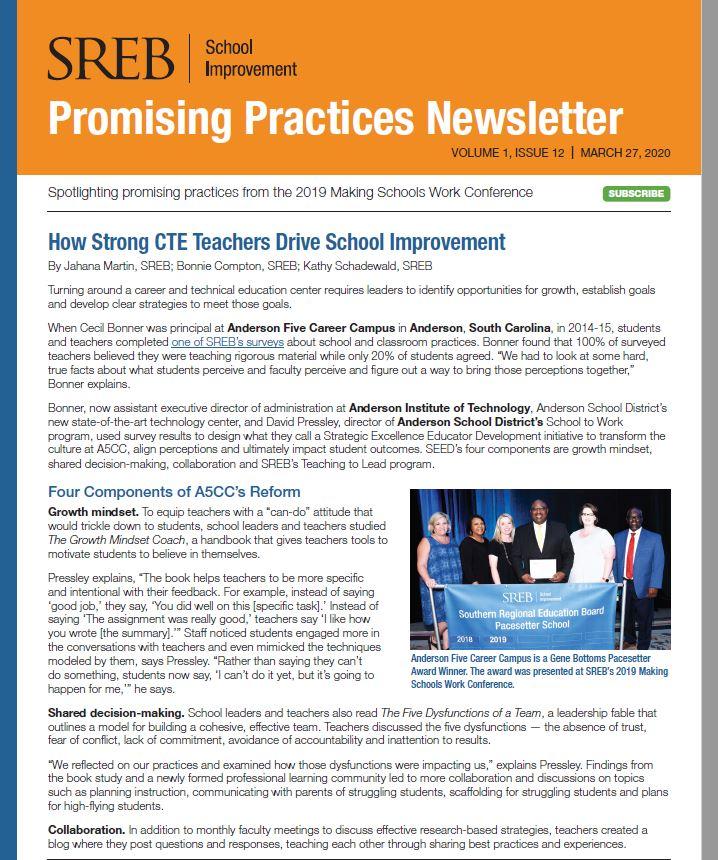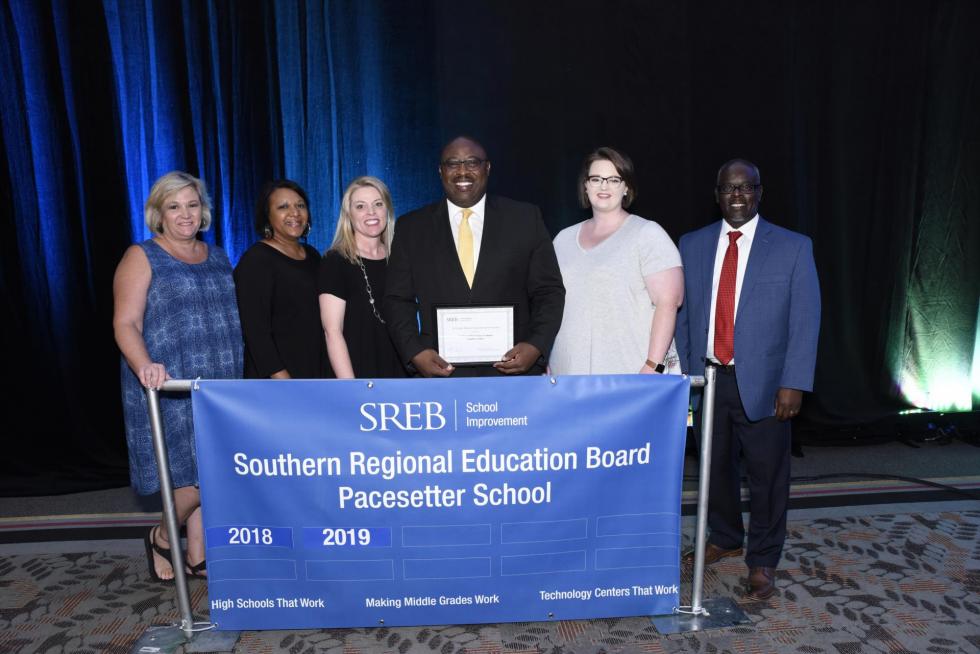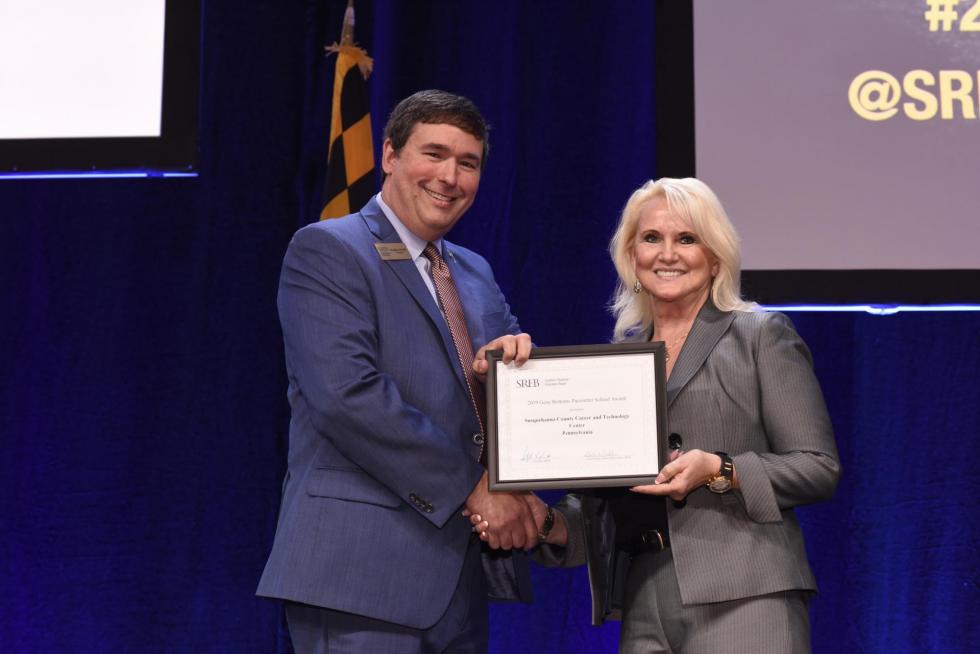How Strong CTE Teachers Drive School Improvement
Spotlighting promising practices from the 2019 Making Schools Work Conference
 Turning around a career and
technical education center requires leaders to identify
opportunities for growth, establish goals and develop clear
strategies to meet those goals.
Turning around a career and
technical education center requires leaders to identify
opportunities for growth, establish goals and develop clear
strategies to meet those goals.
When Cecil Bonner was principal at Anderson Five Career Campus in Anderson, South Carolina, in 2014-15, students and teachers completed one of SREB’s surveys about school and classroom practices. Bonner found that 100% of surveyed teachers believed they were teaching rigorous material while only 20% of students agreed. “We had to look at some hard, true facts about what students perceive and faculty perceive and figure out a way to bring those perceptions together,” Bonner explains.
Bonner, now assistant executive director of administration at Anderson Institute of Technology, Anderson School District’s new state-of-the-art technology center, and David Pressley, director of Anderson School District’s School to Work program, used survey results to design what they call a Strategic Excellence Educator Development initiative to transform the culture at A5CC, align perceptions and ultimately impact student outcomes. SEED’s four components are growth mindset, shared decision-making, collaboration and SREB’s Teaching to Lead program.
Four Components of A5CC’s Reform
Growth mindset. To equip teachers with a “can-do” attitude that would trickle down to students, school leaders and teachers studied The Growth Mindset Coach, a handbook that gives teachers tools to motivate students to believe in themselves.
 Pressley explains, “The book
helps teachers to be more specific and intentional with their
feedback. For example, instead of saying ‘good job,’ they say,
‘You did well on this [specific task].’ Instead of saying ‘The
assignment was really good,’ teachers say ‘I like how you wrote
[the summary].’” Staff noticed students engaged more in the
conversations with teachers and even mimicked the techniques
modeled by them, says Pressley. “Rather than saying they can’t do
something, students now say, ‘I can’t do it yet, but it’s going
to happen for me,’” he says.
Pressley explains, “The book
helps teachers to be more specific and intentional with their
feedback. For example, instead of saying ‘good job,’ they say,
‘You did well on this [specific task].’ Instead of saying ‘The
assignment was really good,’ teachers say ‘I like how you wrote
[the summary].’” Staff noticed students engaged more in the
conversations with teachers and even mimicked the techniques
modeled by them, says Pressley. “Rather than saying they can’t do
something, students now say, ‘I can’t do it yet, but it’s going
to happen for me,’” he says.
Shared decision-making. School leaders and teachers also read The Five Dysfunctions of a Team, a leadership fable that outlines a model for building a cohesive, effective team. Teachers discussed the five dysfunctions — the absence of trust, fear of conflict, lack of commitment, avoidance of accountability and inattention to results.
“We reflected on our practices and examined how those dysfunctions were impacting us,” explains Pressley. Findings from the book study and a newly formed professional learning community led to more collaboration and discussions on topics such as planning instruction, communicating with parents of struggling students, scaffolding for struggling students and plans for high-flying students.
Collaboration. In addition to monthly faculty meetings to discuss effective research-based strategies, teachers created a blog where they post questions and responses, teaching each other through sharing best practices and experiences.
Teachers also collaborate with parents using email updates that include conversation starters about topics covered in class so parents can initiate discussions with their children at home. Parents “love that we’re making contact and they don’t have to be physically at the school to engage. The communication encourages parents’ relationships with teachers,” says Pressley.
Teaching to Lead. Eleven A5CC teachers participated in SREB’s Teaching to Lead program. T2L helps new and early career CTE teachers build capacity to plan instruction, engage students, manage classrooms and create standards-driven assessments. “Teachers now had a tighter grasp on their craft. T2L was also great for veteran teachers to help them refine their craft,” Pressley says.
Bonner and Pressley believe the seeds planted with faculty at Anderson Five Career Campus – growth mindset, distributed leadership, collaboration, professional development and parental involvement – helped improve student outcomes. From the 2014-15 school year to 2018-19, A5CC showed a 24% increase in reading and a 37% increase in math on the standardized WorkKeys employability assessments, and the graduation rate climbed to 99% in 2018-19 from 93% in 2014-15.
Developing Quality CTE Educators
Susquehanna County Career and Technology Center in Springville, Pennsylvania, is also a big advocate for SREB’s Teaching to Lead program.
 “CTE teachers often have little,
if any, training about the concepts that a professional educator
must have to engage students in the learning process,” said Dan
Perna, former teacher, principal, central office administrator
and owner and president of James Daniel & Associates, LLC.
“Professional development can lead excellent technologists
to become excellent professional educators.”
“CTE teachers often have little,
if any, training about the concepts that a professional educator
must have to engage students in the learning process,” said Dan
Perna, former teacher, principal, central office administrator
and owner and president of James Daniel & Associates, LLC.
“Professional development can lead excellent technologists
to become excellent professional educators.”
Perna, along with Alice Davis, executive director of Susquehanna County Career & Technology Center in Springville, Pennsylvania, and SREB’s Linda Floyd identified six needs that must be addressed for technologists to grow into highly effective professional educators.
- Updated, 21st-century pedagogy. Sometimes what a technologist has learned about teaching, they may have learned from being a student or from training in their industry, says Perna. CTE teachers need to learn 21st-century teaching techniques.
- A tailored curriculum. A curriculum is what a teacher teaches and assesses, not what a textbook says. All teachers need to be able to recognize and follow a curriculum as a road map and understand how to design a curriculum.
- Instruction and assessment focused on technical and academic standards. All CTE teachers need to understand the implications and expectations of technical and academic standards and how they interconnect.
- Confidence to engage with academic educators. All CTE teachers need to know and be able to use the language of the professional educator and feel confident discussing the concepts of curriculum, assessment, instructional methods and student engagement.
- Skills and confidence to engage with business and industry advisory groups. All CTE teachers need to develop techniques to gain the most impact when meeting with advisory groups, establish relationships with decision-makers in their respective fields and work with business and industry personnel to stay current with their field.
- Develop and inspire CTE educators to become education leaders. CTE educators with leadership skills should be given opportunities to lead educational initiatives within the school.
Contact(s): Cecil Bonner, cecilbonner@anderson5.net David Pressley, davidpressley@anderson5.net; Dan Perna, jamesdanielassociates@gmail.com

